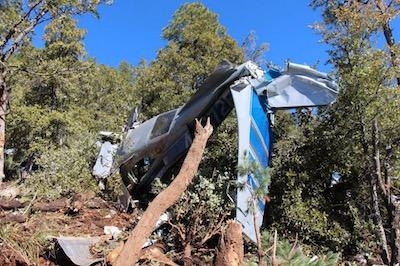Non-Instrument-Rated Pilot Continued Into Below-VFR-Minimums Weather
The NTSB has released its probable cause report from an accident which happened January 2, 2017 that fatally injured four people.

According to the report, the non-instrument-rated private pilot departed his home airport at Scottsdale (AZ) Airport (KSDL) at 0912 local time en route to Telluride, Colorado in a Cessna T210K. There were three family members on board on the cross-country VFR flight over mountainous terrain. The forecast weather conditions called for instrument meteorological conditions (IMC) and mountain obscuration due to clouds, precipitation, and mist along the route of flight and at the accident site. The co-owner of the airplane, who held an instrument rating, had reviewed the pilot's flight plan and the forecast weather conditions two days before the accident and informed the pilot that he should drive to his destination as the weather would not allow for VFR flight. However, the pilot elected to proceed with the flight contrary to the co-owner's recommendation. The pilot entered the flight route into the Foreflight mobile application but did not receive any weather briefings from flight service or the mobile
application before departure.
GPS data recovered from an electronic display device installed in the airplane showed that the airplane departed, entered a climb on a northerly heading, and maintained this direction for the remainder of the flight. After the airplane reached a peak altitude of about 8,000 ft above mean sea level (msl), it descended to 7,000 ft msl and then gradually descended to about 6,000 ft msl, where it remained until near the end of the flight. The airplane subsequently impacted the tops of trees on the rising face of a cliff about 6,600 ft msl. The orientation and length of the wreckage path were consistent with a controlled flight into terrain impact. Track data from the GPS showed that the airplane maintained a straight course after its departure all the way to the mountain rim, which had a published elevation between 6,700 feet msl and 8,000 feet msl. Postaccident examination of the airplane revealed no evidence of any preimpact mechanical malfunctions or failures.
A medical study revealed that each of the 4 fatally injured occupants sustained severe traumatic injuries that would have been rapidly fatal. Furthermore, the study showed there was no evidence to suggest that faster identification of the accident or earlier medical attention would have changed the outcome.
Although the autopilot switch was found in the "ON" position at the accident site, the autopilot was likely not engaged as the airplane's ground track and altitude varied, consistent with the pilot hand flying the airplane.
A weather study revealed that the airplane departed in visual meteorological conditions (VMC) and likely entered a combination of VMC and IMC after it climbed above 7,000 ft. Minutes later, the airplane encountered IMC and did not return to VMC for the remainder of the flight. The pilot's descent from 8,000 ft to 7,000 ft and then to 6,000 ft, occurred after the airplane entered IMC and indicates that he may have been attempting to return to VMC by descending, but was unsuccessful. Upon encountering IMC, the pilot could have turned around and returned to VMC, but he elected to continue and descend about 750 feet below the lowest peak terrain elevation in the area. The airplane's altitude increased rapidly by about 500 ft just seconds before the airplane impacted terrain suggesting that the pilot may have been alerted by the onboard terrain awareness warning system, which had been successfully tested by the co-owner, or observed the terrain and maneuvered to avoid the impact.
The NTSB determined the probable cause(s) of this accident to be the non-instrument-rated pilot's improper decisions to begin and to continue a flight under visual flight rules into instrument meteorological conditions, which resulted in controlled flight into terrain.
(Image from NTSB accident docket)
 ANN's Daily Aero-Term (04.24.24): Runway Lead-in Light System
ANN's Daily Aero-Term (04.24.24): Runway Lead-in Light System ANN's Daily Aero-Linx (04.24.24)
ANN's Daily Aero-Linx (04.24.24) Aero-FAQ: Dave Juwel's Aviation Marketing Stories -- ITBOA BNITBOB
Aero-FAQ: Dave Juwel's Aviation Marketing Stories -- ITBOA BNITBOB Classic Aero-TV: Best Seat in The House -- 'Inside' The AeroShell Aerobatic Team
Classic Aero-TV: Best Seat in The House -- 'Inside' The AeroShell Aerobatic Team Airborne Affordable Flyers 04.18.24: CarbonCub UL, Fisher, Affordable Flyer Expo
Airborne Affordable Flyers 04.18.24: CarbonCub UL, Fisher, Affordable Flyer Expo



